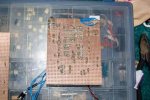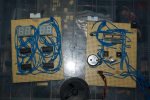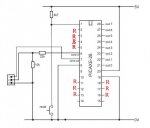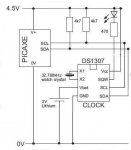Hey All
Its been a while since i have had chance to do any picaxe, or vary much else for that matter. I was thinking about making my an LED alarm clock using some 7 segments displays, 4026s, DS1307 and driven by either a 28X or 18X.
http://www.maplin.co.uk/module.aspx?ITAG=SPEC&ModuleNo=2166&doy=21m5#spec
these are the displays i am going to use in a comon cathode package. i was thinking it would be easier to use a single resistor on the comon pin of each 7 segment and providing i got my maths right it would mena i would only need a 23 ohm resistor. is the a good idea to use the comon pin or should i use individual resistors for each LED? i supose the this makes more sense as the output of the driver will change depending on how many LEDs are lit up.
as for other precautions should unused legs of the 4026B by tied low with a 10K resistor to stop them from floating? will pull down/up resistors be need for the clock and reset pins of the 4026Bs' (these pins will be connected to the picaxe)?
thanks for any help
________
Buddhism Advice
Its been a while since i have had chance to do any picaxe, or vary much else for that matter. I was thinking about making my an LED alarm clock using some 7 segments displays, 4026s, DS1307 and driven by either a 28X or 18X.
http://www.maplin.co.uk/module.aspx?ITAG=SPEC&ModuleNo=2166&doy=21m5#spec
these are the displays i am going to use in a comon cathode package. i was thinking it would be easier to use a single resistor on the comon pin of each 7 segment and providing i got my maths right it would mena i would only need a 23 ohm resistor. is the a good idea to use the comon pin or should i use individual resistors for each LED? i supose the this makes more sense as the output of the driver will change depending on how many LEDs are lit up.
as for other precautions should unused legs of the 4026B by tied low with a 10K resistor to stop them from floating? will pull down/up resistors be need for the clock and reset pins of the 4026Bs' (these pins will be connected to the picaxe)?
thanks for any help
________
Buddhism Advice
Last edited:





